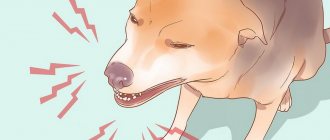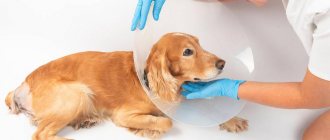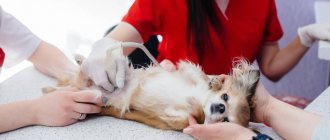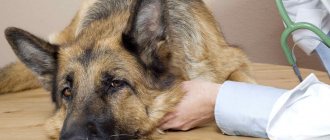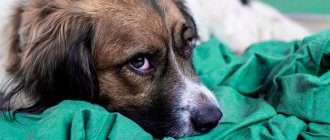Not only people can get sick. Often animals also suffer from various diseases. A disease such as vaginitis is characteristic not only of women, but also of female dogs.
Vaginitis is inflammation of the vagina. More common in young dogs. If the owner notices that his dog is licking the noose, but is not in heat, this is a reason to go to the veterinarian. Also an alarming sign is discharge from the loop. Most often, owners notice them on furniture or carpets. The disease occurs in all dogs, regardless of whether the dog is sterilized or not. Bacteria don't care about this fact. If vaginitis occurs in a pregnant dog, there is a risk of miscarriage or stillbirth of the puppies.
Causes
Many reasons can contribute to the development of this disease in dogs. Vaginitis is caused by various bacteria that enter the body. This most often occurs in dogs that have not reached sexual maturity. The amount of estrogen in the blood decreases, which means the resistance of the mucous membranes to various irritants decreases. Thus, pathogens penetrate the mucous membranes and cause disease.
Some believe that vaginitis occurs in all dogs during their first heat, and in some even before it. Vaginitis can also develop due to inflammation of the uterus.
Traumatization of the vaginal mucosa allows pathogenic microflora to pass through. Most often, such damage occurs during sexual intercourse, during childbirth, or during medical procedures. This often happens if the male dog with whom the mating took place is also sick with something. The mucous membrane does not protect the body and bacteria freely penetrate inside.
Can a dog lick his butt while in heat?
During estrus (estrus), the female's hormonal levels malfunction. On critical days, the physiological processes and behavioral manners of the lady change. She becomes cunning and inventive. May refuse to go to the toilet outside until the leash is removed. But immediately after that he will run off to look for the groom.
At the moment of emptying, bitches are characterized by nervousness, some individuals show aggression. Bloody discharge appears - clean representatives of canines clean up after themselves. At this time, the dog can lick its anus - this is normal, there is no talk of pathology.
Symptoms
For timely treatment of the disease, it is necessary to know the symptoms corresponding to vaginitis. The main symptoms are a swollen vulva and discharge from the loop. The discharge is viscous and may be white or greenish in color. The genitals may be inflamed, swollen, and reddish in color. This is accompanied by painful sensations in the dog. In addition to the main symptoms, there are other signs that should concern owners:
- Itching in the genital area. Scratching or biting may occur.
- Due to the release of exudate, the fur in the genital area is stuck together.
- Dog anxiety.
- Temperature increase.
- Bloody or purulent discharge from the genitals.
List of possible pathologies
If the owner begins to notice that his dog often licks his butt, then the following possible reasons should be considered:
Worms
The most common reason why a dog licks its butt more than usual.
Some owners naively believe that it is enough to worm their pet once a year, but, as practice shows, this procedure should be carried out at least twice a year for all animals living together.
In most cases, worms are discovered when problems with weight appear (rapidly losing weight), the dog becomes lethargic, which is not typical for its age. In some cases, worms can be found in feces.
To confirm the diagnosis, a stool test for helminth eggs may be necessary. The drugs Kanikvantel, Drontal, Febtal are used for treatment.
Much attention is paid to disinfection (all surfaces that an infected pet comes into contact with are treated with chlorhexidine solution and bleach).
Complete recovery is considered to be the absence of eggs and helminths in the stool after 3-4 tests. It should also be remembered that after deworming for 1-3 days, worms may be present in the feces.
Remember that the first deworming is carried out when the puppy is three weeks old, then once every three months or at least twice a year throughout his life!
Allergy
May cause redness and swelling in the anal area. Itching and discomfort will force the dog to pay increased attention to this area. This can manifest itself in licking (if enough), gnawing.
Your pet may also scratch this area on hard or sharp surfaces. Such a reaction can be provoked by switching to a new food (it may not be suitable), food from the table (sweets, fruits, flour), or long-term use of antibiotics.
In summer, the cause may lie in plants if the dog has access to tall grass. You need to understand that tests are not performed to confirm the diagnosis, so the allergen has to be identified by exclusion (if it is a matter of nutrition) or by limiting access to potentially dangerous substances and plants.
During an exacerbation and in the presence of severe itching, Suprastin (usually half a tablet) or Fitex drops help (consult a specialist before giving anything).
Insect bites
Animals that spend most of their lives outdoors suffer especially. Most often dogs are bitten by flies, gadflies and ants. At the site of the bite, you can find red bumps the size of a pea.
Naturally, the pet will try to lick or scratch this area. The anus area is a favorite place for small insect bites.
Tumor
The most unpleasant and dangerous reason that a dog constantly licks under its tail may be a tumor process.
It occurs mainly in animals older than 10 years. At the initial stage, it may appear in the form of small nodules that do not bother the pet in any way. As the process progresses, their size can increase to that of a chicken egg.
Ulcers, pus and blood discharge may appear in the same place. The whole process is accompanied by excruciating pain and discomfort.
Particular attention is paid to gender, since malignant tumors are less common in males, and castration helps prevent their occurrence.
If any formations are detected in the anal area, it is necessary to conduct a histological examination of tissue taken from the tumor with a long-barreled needle.
The treatment regimen depends on many factors, ranging from the stage and aggressiveness of the formation, to the age and ability of the animal to tolerate anesthesia. In most cases of squamous cell carcinoma or sarcoma, the prognosis is guarded. They try to make life as easy as possible for the pet with the help of painkillers.
Inflammation of the perianal sinus
Quite a common phenomenon among decorative breeds. If the excretory duct is clogged and there is no way for secretions to escape, then there is a possibility of developing an inflammatory process, due to which the perianal glands may become swollen or inflamed.
This is why a dog can often lick under its tail, although, at first glance, there is nothing dangerous there. The problem can be solved by flushing the gland through an inserted catheter. In severe cases, antibiotic therapy may be needed.
Forms
There are several forms of this disease.
- Serous . Discharge of a transparent or translucent color.
- Catarrhal . The discharge is white, thick in consistency.
- Fibrinous . Characterized by the presence of fibrin films on the mucous membrane. Removal of which causes erosion and ulcers.
- Purulent . Discharge of greenish purulent contents with a characteristic odor;
- Juvenile . It occurs due to hormonal changes in the dog’s body and is characterized by clear discharge.
- Gangrenous . The most severe form, in which tissue rotting occurs. It is characterized by discharge with pieces of dead tissue, accompanied by a characteristic smell of rot.
In severe forms, in addition to discharge and general symptoms, intoxication of the body may occur. The dog becomes lethargic and sometimes refuses food. Sometimes she may yelp in pain and act differently than usual.
What are anal glands
Once or twice a day, the dog turns to its anus - licks it, bites it, which is quite normal. This way she cleanses the butt from the remains of feces and dirt. This is a natural hygienic procedure and should not be interfered with. But, if the dog constantly licks the base of the tail, tries to reach it, and squeals, the owners should check the condition of the pet’s anal glands.
The dog licks under the tail
Location and function
Paraanal glands (sinuses) are sacs with secretion, a hormonal odorous substance. They are located at the exit of the anus, on the inside. The ducts exit into the rectum.
Note! The exact location of the organs can be determined by imagining the dog’s anus as a clock face. The bags are located where the arrows show 4:00 and 8:00.
The smell of the substance from the paraanal glands is unique, like human fingerprints. The dog uses it to mark the hunting territory and attract individuals of the opposite sex. When dogs get to know each other, they sniff each other's tails - they remember the new smell.
How glands work
The secretion is produced continuously throughout the dog's life. Daily self-cleaning occurs along with feces when the animal goes to the toilet. During a walk, the dog itself squeezes out the liquid - “shoots” it out of the anus in order to leave its “calling card” on a bush or pole.
The glands are also cleansed during active games and stress. If the sacs are not emptied, the secretion accumulates in them and thickens. The pet begins to worry, the owners notice that the dog is licking its anus.
Note! When the self-cleaning of the anal glands stops, the pet first experiences discomfort, then itching and pain. To calm them down, the dog constantly licks the groin.
Treatment
For good treatment results, it is necessary to contact a veterinarian as early as possible and carry out the entire course of treatment under his supervision. Also, timely detection of the disease will avoid many complications.
Many people believe that juvenile vaginitis does not require treatment. Since this is a hormonal disorder, the balance is restored after the first heat and the disease goes away along with it. Others believe that treatment is still required and for this it is necessary to introduce estrogen into the dog’s body, but with a reduced dosage.
However, the prescription of hormonal drugs, on the contrary, is harmful to the dog’s health. Therefore, they are practically not prescribed for treatment.
To make an accurate diagnosis, a smear is taken from the dog. Next it is sent to the laboratory. There they find out what pathogen causes the disease in order to correctly prescribe antimicrobial therapy.
For dogs that have reached sexual maturity, do not use topical treatment alone. It is always combined with antibacterial therapy. In severe forms, such as catarrhal or purulent, antibacterial ointments are used for local treatment.
How is the diagnosis carried out?
The exact type of vaginitis and the current methods of its treatment are determined by the doctor only after a comprehensive examination of the animal and receipt of the results of laboratory tests. Among the current diagnostic methods in this case are colposcopy (examination of the vagina using a special colposcope device), ultrasound, examination of vaginal smears, in particular, the sensitivity of microorganisms to various groups of antibiotics.
One of the main tasks of the doctor is to exclude other diseases with similar symptoms (for example, brucellosis)
Prevention
To avoid illness, you need to know preventive measures for your pet.
The following points must be remembered:
- It is necessary to maintain dog hygiene and keep the animal clean;
- The mating of a dog must be carried out with a healthy male, so there is no risk of infection during sexual intercourse;
- It is necessary to maintain a balanced diet;
- Food must contain sufficient amounts of vitamins and microelements;
- It is necessary to monitor the general health and immunity of the animal;
- Timely vaccination can protect against many diseases.
Thus, by observing all of the above preventive measures, the owner will be able to protect his dog from this disease. If the disease is detected early, it can be treated quite easily. It is very important to notice the first symptoms at an early stage, otherwise the disease can lead to serious complications.
When to contact a veterinarian
The problem with the anal glands is not terrible if it does not lead to inflammation. When a ward has a balanced menu and proper exercise, if he has not injured his anus during games, there is no need to remember the existence of sinuses.
But if the process has begun, purulent and watery discharge, swelling and a heavy odor appear, the pet is taken to the veterinarian. The dog often licks its tail; a specialist will figure out why. He will conduct an external examination, do an ultrasound of the abdominal cavity, and take urine, blood and stool tests to rule out helminths. A professional will also clean the glands.
Some individuals need the procedure once a year, others more often. If the owners are forced to squeeze out secretions from the glands every week, then it is more humane to remove the organ. Veterinarians carefully operate on the sufferers, and within a day they return to normal.
The dog licks its groin, becomes nervous, and whines - this may indicate a disruption in the natural process of self-cleaning of the anal glands. They produce an odorous enzyme that dogs use to mark their territory and attract individuals of the opposite sex. If a dog doesn’t walk much or has problems with bowel movements, then feces do not squeeze out secretions from the anal sacs. Stagnation of the substance leads to inflammation, suppuration, and abscess. The owner must help his dog cleanse the glands. When the disease is severely advanced, you should contact a veterinary clinic.
It’s worth starting right away with the fact that a condition is considered pathological when a dog licks its tail more than once a day, and the duration of this procedure can exceed several minutes. It must be remembered that most animals in this way have the opportunity to clean the anus of feces or other contaminants. This is considered normal and does not apply to pathological conditions.
It is more difficult for breeds that cannot reach their anus (English bulldogs, for example), and they solve this problem by “riding on their butt” on carpets, grass and other surfaces convenient for this procedure.
- List of possible pathologies
- Worms
- Allergy
- Insect bites
- Tumor
- Inflammation of the perianal sinus
- Conclusion



